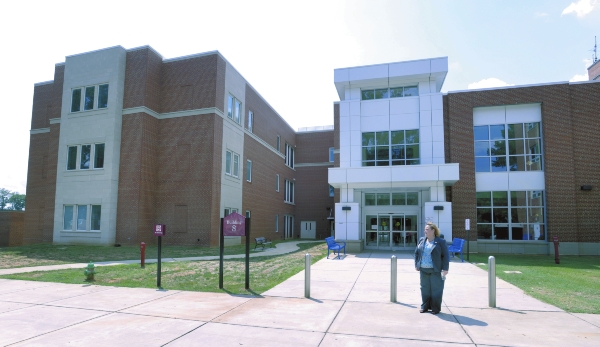Chief: VA evolving in approach to patients, input from staff
Published 12:05 am Wednesday, July 29, 2015

- Then-director Kaye Green stands in front of the new mental health building at the Hefner VA Medical Center in 2015. Photo by Wayne Hinshaw; for the Salisbury Post
By Elizabeth Cook
elizabeth.cook@salisburypost.com
A congested hallway greeted Kaye Green, director of the Hefner VA Medical Center, as she was showing a reporter and photographer around the hospital campus Tuesday.
Seated in chairs and wheelchairs at the entrance of one of the campus’ busiest buildings, patients were waiting to have blood drawn — as they have done for years.
Recently, someone offered a simple solution: Why not move the phlebotomy area to an empty room at the end of the hallway?
It’s in the works.
The move is a small example of countless changes Green and her colleagues say the Hefner VA Medical Center has been undergoing in the past year.
Fifteen months after alarming wait lists at VA hospitals around the country made news, Hefner VAMC officials speak of a transformation — a change in culture for the staff and a change in approach to patient care.
Dr. Parag Dalsania, associate chief of staff in primary care, said the hospital’s model is moving from asking patients “what’s the matter with you” to “what matters to you?”
In addition to the shift to patient-centric care and wellness, Green said staff members have been empowered to manage their own areas, communicate with others and suggest better ways to do things.
“We have made a lot of improvements over the past year,” Green said. Her team mentions concepts found in manufacturing, such as continuous improvement and lean management.
As the hospital becomes more efficient, employees are happier and outcomes are improved, Green said.
For example, a year ago the hospital was hearing from unhappy vets who had prepped and fasted for a 9 a.m. endoscopy appointment — only to wait until after lunch to be seen.
A continuous improvement team examined the process, made changes, and now patients are seen within an hour; some who arrive early are seen even before their appointment, according to Green.
Tammy Watkins, nurse manager of gastro-endorology, has displayed the data from her unit on a bulletin board to track the improvements. But the most telling results are on a different bulletin board — “Endo Rocks” — where staff members post patient comments.
One vet sent in a hand-written note : “I want to thank everyone associated with the procedure. It went great and I thank you all. … I feel blessed to have you as my health care providers.”
More money
An influx of new cash followed the national outcry over wait times. The Salisbury VA — which includes several clinics and a 24-county cachement area — initially received $12 million, $1 million of which went into new equipment and $11 million to help veterans get care in the community at the VA’s expense.
Then, following passage of the $15 billion Veterans Choice Act, the medical center received just under $14 million more for staffing for 2015-16.
The center has hired eight additional physicians; it now has specialists in endocrinology, oncology, ophthalmology, gastro-enterology. A handful more are in the pipeline to join the staff soon, Green said.
But the medical center needs more psychiatrists, perhaps the most difficult specialty to staff. Green said medical schools are not training enough psychiatrists. Also, awareness of post-traumatic stress disorder has grown, she said, and more veterans are seeking treatment. The Salisbury VA, which includes several clinics in a 24-county coachmen area, has 46 psychiatrists on staff now and needs 12 more.
Waiting for appointments
The Salisbury VA was in better shape than most when wait times started getting so much scrutiny last year, Green said. Her team had already studied the data and hired “gap providers” to improve the situation.
Primary care can get in a new patient in about three days. Dalsania said the average primary care wait is around 10 days; 90 percent get seen within 30 days, and many are seen on a same-day basis.
“We want to get down to zero,” Dalsania said, “and we think we can get there. Ten days is good, but we can do better.”
Green said 93 percent of new patients can be seen in specialty care within 30 days, the timeliness goal set by the VA. For established patients, 96 percent get seen within 30 days.
Outside care
For those looking at longer than a 30-day wait — or who live more than 40 miles from a VA facility — the Choice Act provides funds for them to be seen by providers in their community.
While the first injection of funds last year enabled the VA to make appointments outside the system for patients, the Choice program calls for patients to make the contact themselves. The program is administered by two contractors in the country; Healthnet in the east and Tri-Care in the west. The onus is on the veteran to call Healthnet to connect with a provider who can see them.
Patients don’t always like dealing with outside doctors; they’re used to VA care.
So is the VA.
“We’re used to really managing care for veterans,” Green said. “It’s tough to let go.”




